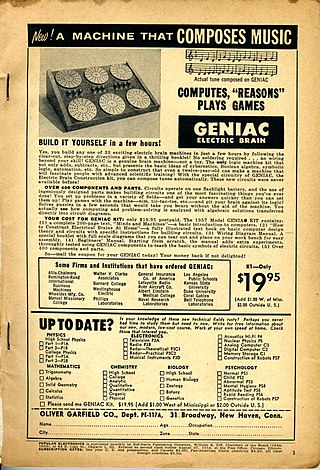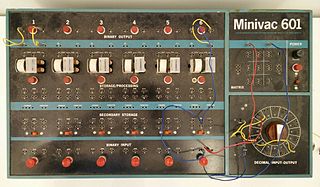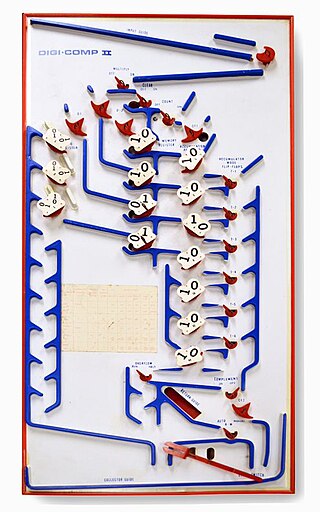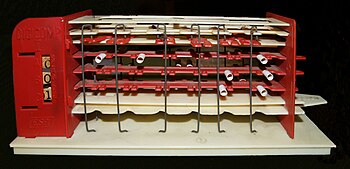In digital logic and computing, a counter is a device which stores the number of times a particular event or process has occurred, often in relationship to a clock. The most common type is a sequential digital logic circuit with an input line called the clock and multiple output lines. The values on the output lines represent a number in the binary or BCD number system. Each pulse applied to the clock input increments or decrements the number in the counter.

A logic gate is a electronic device that performs a Boolean function, a logical operation performed on one or more binary inputs that produces a single binary output. Depending on the context, the term may refer to an ideal logic gate, one that has, for instance, zero rise time and unlimited fan-out, or it may refer to a non-ideal physical device.

Digital electronics is a field of electronics involving the study of digital signals and the engineering of devices that use or produce them. This is in contrast to analog electronics which work primarily with analog signals. Despite the name, digital electronics designs includes important analog design considerations.
A shift register is a type of digital circuit using a cascade of flip-flops where the output of one flip-flop is connected to the input of the next. They share a single clock signal, which causes the data stored in the system to shift from one location to the next. By connecting the last flip-flop back to the first, the data can cycle within the shifters for extended periods, and in this configuration they were used as computer memory, displacing delay-line memory systems in the late 1960s and early 1970s.

The PDP-6, short for Programmed Data Processor model 6, is a computer developed by Digital Equipment Corporation (DEC) during 1963 and first delivered in the summer of 1964. It was an expansion of DEC's existing 18-bit systems to use a 36-bit data word, which was at that time a common word size for large machines like IBM mainframes. The system was constructed using the same germanium transistor-based System Module layout as DEC's earlier machines, like the PDP-1 and PDP-4.
In information technology and computer science, a system is described as stateful if it is designed to remember preceding events or user interactions; the remembered information is called the state of the system.

The 4000 series is a CMOS logic family of integrated circuits (ICs) first introduced in 1968 by RCA. It was slowly migrated into the 4000B buffered series after about 1975. It had a much wider supply voltage range than any contemporary logic family. Almost all IC manufacturers active during this initial era fabricated models for this series. Its naming convention is still in use today.

Geniac was an educational toy sold as a mechanical computer designed and marketed by Edmund Berkeley, with Oliver Garfield from 1955 to 1958, but with Garfield continuing without Berkeley through the 1960s. The name stood for "Genius Almost-automatic Computer" but suggests a portmanteau of genius and ENIAC.
E.S.R., Inc. was an American manufacturer of educational toys during the 1960s. The company’s founders included William H. Duerig and Irving J. Lieberman, both involved in missile research at Kearfott Guidance in New Jersey, and C. David Hogan, an engineering student at Stevens Institute of Technology. Together the three brainstormed Lieberman’s concept for a simple mechanical computer, and showed a prototype at the annual Toy Fair in New York City.

The Motorola 68881 and Motorola 68882 are floating-point units (FPUs) used in some computer systems in conjunction with Motorola's 32-bit 68020 or 68030 microprocessors. These coprocessors are external chips, designed before floating point math became standard on CPUs. The Motorola 68881 was introduced in 1984. The 68882 is a higher performance version produced later.

Minivac 601 Digital Computer Kit was an electromechanical digital computer system created by information theory pioneer Claude Shannon and sold by Scientific Development Corporation as an educational toy using digital circuits.
A ring counter is a type of counter composed of flip-flops connected into a shift register, with the output of the last flip-flop fed to the input of the first, making a "circular" or "ring" structure.

The Digi-Comp II was a toy computer invented by John "Jack" Thomas Godfrey (1924–2009) in 1965 and manufactured by E.S.R., Inc. in the late 1960s, that used 1⁄2 inch (12.5 mm) marbles rolling down a ramp to perform basic calculations.
Dr. Nim is a toy invented by John Thomas Godfrey and manufactured by E.S.R., Inc. in the mid-1960s. It consists of a marble-powered plastic computer capable of playing the game of Nim. The machine selects its moves through the action of the marbles falling through the levers of the machine.

Educational toys are objects of play, generally designed for children, which are expected to stimulate learning. They are often intended to meet an educational purpose such as helping a child develop a particular skill or teaching a child about a particular subject. They often simplify, miniaturize, or even model activities and objects used by adults.

A mechanical computer is a computer built from mechanical components such as levers and gears rather than electronic components. The most common examples are adding machines and mechanical counters, which use the turning of gears to increment output displays. More complex examples could carry out multiplication and division—Friden used a moving head which paused at each column—and even differential analysis. One model, the Ascota 170 accounting machine sold in the 1960s calculated square roots.

In computing, an emulator is hardware or software that enables one computer system to behave like another computer system. An emulator typically enables the host system to run software or use peripheral devices designed for the guest system. Emulation refers to the ability of a computer program in an electronic device to emulate another program or device.

A vacuum-tube computer, now termed a first-generation computer, is a computer that uses vacuum tubes for logic circuitry. While the history of mechanical aids to computation goes back centuries, if not millennia, the history of vacuum tube computers is confined to the middle of the 20th century. Lee De Forest invented the triode in 1906. The first example of using vacuum tubes for computation, the Atanasoff–Berry computer, was demonstrated in 1939. Vacuum-tube computers were initially one-of-a-kind designs, but commercial models were introduced in the 1950s and sold in volumes ranging from single digits to thousands of units. By the early 1960s vacuum tube computers were obsolete, superseded by second-generation transistorized computers.













